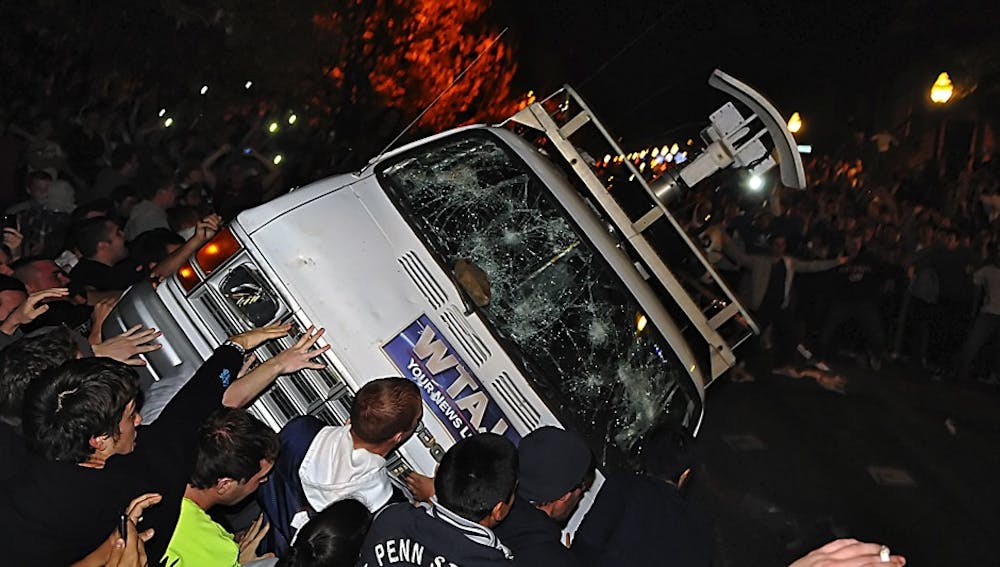While Pennsylvania State University is more than 150 miles away from Philadelphia, its Board of Trustees’ decision to fire football coach Joe Paterno and President Graham Spanier has resonated here at Penn.
Paterno and Spanier were released from Penn State on Wednesday night as a result of a grand jury report that outlined the alleged sexual offenses performed by former Penn State defensive coordinator Jerry Sandusky. The report alleges that in 2002, a graduate assistant witnessed Sandusky raping a young boy and brought the incident to Paterno’s attention.
“This is a tragedy, particularly for the young people whose lives have been devastated,” Penn President Amy Gutmann said. “Our thoughts and prayers go out to them and their families.”
Paterno’s firing has prompted a mass outcry from the Penn State community, with more than 4,000 protesters descending on downtown State College Wednesday night in what The Daily Collegian, the school’s student newspaper, described as “a riotous mob.”
The scandal has highlighted issues of sexual abuse, problems with the current climate of college sports and — for the Penn community — an ongoing confusion between Penn and Penn State.
“I’ve seen the way the culture of football could subsume and take over a community and do damage to kids,” Friday Night Lights author and 1976 College graduate H.G. “Buzz” Bissinger said. “Sports is overtaking our academic institutions.”
TIMELINE: Penn State sex abuse scandal
Beyond the playing field
under the button
While Bissinger, a former Daily Pennsylvanian sports and opinion editor, feels that Sandusky’s alleged sexual offenses relate to this “absolutely ridiculous” college sports culture, others believe the alleged rape and subsequent cover-up are less about sports and more about the pervasiveness of sexual predatory behavior and institutions’ inabilities to deal with offenses.
“It’s not about Paterno being a god or the program being in a cocoon,” Dean of the School of Social Policy & Practice Richard Gelles said. Gelles has been a close friend of Spanier for more than 40 years.
Around one in 11 boys under the age of 18 are sexually abused — roughly a third of those by non-family members, according to Gelles.
“To think this is something happening only at Penn State is naive,” Gelles said. “This is something that can happen at any campus at any time, and complications in handling the situation occur in every instance.”
Gelles feels that Spanier could have asked more questions and investigated further when dealing with the allegations against Sandusky.
“But that doesn’t take away from the fact that he’s a fine human being,” Gelles added.
Gelles hopes that the grand jury report will help send a message to take a stand against sexual abuse.
“If it causes universities like ours to better handle predators no matter who the person is, then the attorney general has done the right thing and everything else is collateral damage,” he said.
To Bissinger, the problem relates to a sports culture that blurs the line between academics and athletics in institutions across the nation.
“Sports has nothing to do with academics,” Bissinger said. “We’re the only western society that recruits in virtually every sport, and it’s sucking the air out of our institutions and causing scandal after scandal.”
‘Not Penn State’
The events have also drawn attention to the confusion between Penn and Penn State by both the media and the public.
An op-ed by Maureen Dowd published on Tuesday in The New York Times was originally headlined “Personal Foul at Penn.”
Dowd concluded by writing she could only hope Paterno “and the other Penn scoundrels will have been ignominiously cast out of what turns out to be a not-so-Happy Valley.”
After the Times received a request for a correction from the Office of University Communications, it fixed both errors.
“Whenever there is any misstatement, whether on our name or anything else, we work to set the record straight,” Vice President for University Communications Stephen MacCarthy wrote in an email.
The Times’ Vice President of Corporate Communication Eileen Murphy expressed the paper’s regret for the error, noting in an email that “what was confused initially was not the two distinct universities, but the shorthand.”
Nevertheless, that error and another by a British Broadcasting Corporation sports show which University Communications was told would be corrected demonstrate the failure of many to distinguish between the shorthand names for the two universities.
“The fact that [the Times is] making the error is disgraceful and unfair to the institution,” Bissinger said, calling the mistake “inexcusable sloppiness.”
According to University Archives and Records Center Director Mark Frazier Lloyd, Penn likely received its shorthand name in the 1890s. Sportswriters were the first to don the university “Penn.”
The Pennsylvania Gazette also called the university “Old Penn” when the magazine was founded in 1902.
Penn State also received its shorthand nickname due to sportswriters covering football, but around 50 years later.
“I think Maureen Dowd shouldn’t get us mixed up,” Lloyd said. “I certainly understand it, but I don’t condone it. People should be certain they’re calling you by the correct name.”
Director of Athletic Communications Mike Mahoney received around five emails expressing support or disapproval of the actions taken against Paterno.
To each, he thanked the sender for their comments but let them know, “we are actually the University of Pennsylvania and not Penn State University.”
MacCarthy also received an email requesting to “fire Joe Paterno.”
The confusion dates at least as far back as 1979 when Penn made the Final Four and “Not Penn State” T-shirts — still sold in the bookstore — were popularized, according to Vice President for Business Services Marie Witt.
While MacCarthy noted that University Communications is aware of just these two errors in covering the events at Penn State in more than 18,000 stories, the mistakes still offend some.
“We are Penn, not Penn State,” Bissinger said, “and today, we definitely do not want to be Penn State.”
SEE ALSO
Under the Button: Hey Maureen Dowd, We’re Not Penn State



